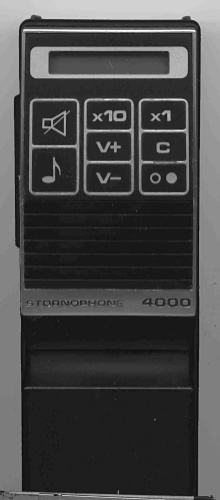PA3DBJ


My latest project: the Storno 4000
At the end of the 1980's, the Storno 4000 was the latest technology in handheld radiocommunications.
The Storno 4000 was in service in many police and fire brigades in our country for the last decade, but with
the new radio systems, they have become obsolete and can be bought quite cheap in surplus shops now.
Can they be modified for radio amateur use ?
The answer to this question is: YES, but there are some restrictions.
First of all, we need to find out what model we have. There are several models covering
different bands, and not all models can be modified to operate on amateur radio frequencies:
- CQP411xS01y: VHF 144 - 176 MHz model, 2 channels
- CQP411xS02y: VHF 144 - 176 MHz model, 10 channels
- CQP433xS01y: VHF 66 - 88 MHz model, 2 channels
- CQP433xS02y: VHF 66 - 88 MHz model, 10 channels
- CQP466xS01y: UHF 400 - 470 MHz model, 2 channels
- CQP466xS02y: UHF 400 - 470 MHz model, 10 channels
- CQP4552S01y: UHF 350 - 400 MHz model, 2 channels
- CQP4552S02y: UHF 350 - 400 MHz model, 10 channels
As you can see, only the CQP411x and CQP466x models can be tuned to the 2m and 70 cm radio amateur bands.
So if you own one of these models, you are lucky.
One remark about the type numbers: the last number ("x") refers to the channel spacing of the equipment:
2 stands for 25 kHz, 3 for 20 kHz, and 4 for 12.5 kHz.
There are also "Z" models in circulation (CQP4xxxZ02y), that use a 2764 EPROM for programming. I have some,
but not much information on these models. If you have any information, please let me know.
So what do you need to do? Well, you need to readjust the trimmers and coils,
but that is something most radio amateur can do with their eyes closed... but: there is something else that
is essential to get these nice handhelds to work...you need to make a "Personality PROM".
If you open the radio, you will find the tone module (the substrate) - if present, plugged into the main board.
If one of the pins (pin #8) is cut off or bent, don't worry - this is to establish another "group call" tone.
On the main board, you will find a socket for the "Personality PROM". This is a 256 x 4 bits PROM, e.g.
a 82S129N.
The Personality PROM
The documentation on this item is abt. 45 pages in length, but I explain what type of information the
Personality PROM actually holds in a few lines:
- Channel spacing;
- Transmit and Receive Frequencies for all channels;
- Tone Telegrams (if a tone unit is installed) for selective calls;
- CTCSS, or Channel Guard information for tone squelch encoding and decoding;
- All kinds of squelch and tone transmission settings - if you don't use all the tone options,
you can save yourself a lot of trouble programming these.
I have tried to put all the essential information into a spreadsheet. JavaScript commands perform all
calculations faster than you can do on a piece of paper.
At this moment, I have completed and tested the 2 channel version.
Just fill in the fields, press the "calculate" button, and the PROM contents will show up at the bottom of the
page, ready to print on your printer. Leave the unused locations unprogrammed. If the initial value of a word
in your PROM is "0", don't change it. If it is "F",
don't change it either. I have added "Cut & Paste" tables to copy your data to your PROM programming software.
Have fun!
Don't hold it against me if I made a mistake somewhere, the manual isn't "crystal clear" about some of the
options, and I am not a JavaScript expert, or at least I wasn't one when I started this project. The pages
should work in Netscape 4.x, Mozilla, and MSIE 4, or later.
There are two different 10 channel versions of the Storno 4000: one with a tone module and one without it.
These two versions differ a lot w.r.t. programming. If you are sure you own a 10 channel model without a tone
module, you can try programming the PROM using my 10 channel (NO tones) form.
This form is relatively well-tested, but may have one or two minor bugs.
If you own a 10-channel version WITH a tone module, you can use my EXPERIMENTAL
10 channel (WITH tones) form.
NOTE: this page is NOT FULLY TESTED and still INCOMPLETE. Reading the manual over and over again, some of the
options are still unclear to me. It seems that the tone module installed in most of the equipment that appeared
on the Dutch surplus market recently is the TQ4006 module.
Please mail me if you have any comments.
MORE REFERENCES:
More documentation on programming the Storno 4000
by Wim Ton
The unofficial Storno / Motorola Programming Page
Back to my homepage
© 1998 - 2004 a PA3DBJ production



